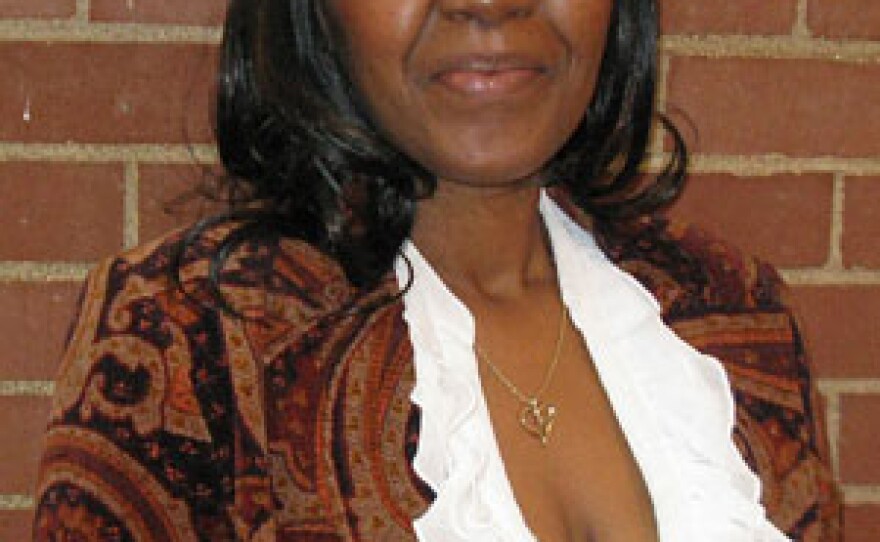http://stream.publicbroadcasting.net/production/mp3/national/local-national-959177.mp3
More than a million Americans are living with HIV, the virus that causes AIDS. About a quarter of them are women, and in St. Louis and throughout the country, African-American women are disproportionately affected.
An HIV diagnosis can lead not just to debilitating medical problems, but to social stigma and isolation. But as St. Louis Public Radio’s Véronique LaCapra reports, a photography project is giving some HIV-positive women a new way to look at their disease and its challenges.
------------------------------
University of Missouri-Columbia researcher Michelle Teti has been doing HIV prevention work for about 10 years. She says she was struck by what she saw as a mismatch between what public health programs were offering and what HIV-positive women said they needed.
“Sometimes HIV wasn’t even the biggest priority,” Teti said. “They might not have had housing. They might have been in violent relationships. So I decided to take a step back and find ways to let women identify their health priorities, and identify problems, and identify solutions.”
With the help of health organizations in Philadelphia and St. Louis, Teti recruited HIV-positive women to participate in a photography project. She gave the women digital cameras, taught them how to use them, and sent them out to photograph their lives.
Some women took pictures of themselves. Others photographed people in their support networks, or specific challenges they were facing, like substandard housing. And many, Teti says, used the photographs to show how they had worked to change their lives after being diagnosed with HIV.
“A lot of women when they found out they were living with this virus felt kind of desperate or hopeless, and a lot of women described a transition, or transformation, to a place where they were more hopeful and healthy,” Teti said.
“It’s going to take a lot of work, but it can be fixed”
In December 2001, 26-year-old St. Louis resident Tamika Taylor Jackson found out she was HIV-positive.
“When I first was diagnosed it was a very hard and emotional thing for me,” Jackson said.
While she was in the hospital, her husband left her. Then the bank foreclosed on her house, leaving her with three young children, and nowhere to live.
“And some of the closest people that I thought would be there for me was not there for me because they thought I was just a big disease, a big germ,” Jackson said.
Jackson says she used the photography project to show how she has transformed her life since her diagnosis.
She shows me a photograph of a caved-in section of pavement on a dark, rain-soaked street. She says that big, deep hole reminded her of how broken she looked and felt when she first found out she had HIV – and of how much better she’s doing, now.
“I said as big as this looks, and it looks like it can’t even be repaired, but it can. It can. [There’s] hope for it! Said looks like it’s going to take a lot of work, but it can be fixed,” Jackson said.
Shoes to show progress
Jackson took pictures of the houses she’s lived in. She took pictures of the medications she takes, and of the spiritual books she reads, for inspiration. And she took pictures of her shoes. Not real shoes to wear, but miniature ceramic ones, in brightly-colored patterns. She has about a dozen of them, prominently displayed on shelves near her front door.
“Every time I’ve accomplished something, I always go out and find a shoe to reward myself with. I’ve made progress, I’ve stepped up, I’ve achieved something, so I’m gonna go find me a shoe,” Jackson said.
The first one was a gold boot.
“And I purchased that when I realized to myself that, OK, I want a divorce. Then came I believe the zebra-striped shoe at the top,” Jackson said.
That shoe was for finding a place to live.
“Then,” Jackson said, “came the yellow shoe.”
That was when she met her boyfriend. Jackson bought a shoe when she found a better house, when she got a job, when she bought a car, and she bought a shoe when she moved into the home she lives in with her children, today.
“And I was like oh thank you, I’m doing it, I’m moving up!” Jackson said.
Holding on to transformation
Researcher Michelle Teti says she hopes all the women in the photography project can hold on to that feeling of positive transformation.
“They’re just really strong women and really just committed to being healthy and being better, and this process allows them to reflect on that,” Teti said.
Teti says participating in the photography project can give HIV-positive women a new way to look at their lives, to figure out what they may still want to change and to congratulate themselves for what they’ve done right.
You can see some of Jackson’s photographs above.
Additional Information:
- City of St. Louis Department of Health: http://stlouis.missouri.org/citygov/health/worldaids.html
- Saint Louis Effort for AIDS: http://www.stlefa.org/
- Project Ark (AIDS/HIV resources): http://projectark.wustl.edu/
- Centers for Disease Control and Prevention (HIV and women): http://www.cdc.gov/hiv/topics/women/index.htm
- Statistics on HIV in Missouri:
- http://www.cdc.gov/nchhstp/stateprofiles/usmap.htm
- http://www.statehealthfacts.org/profilecat.jsp?rgn=27&cat=11




![“This little raggedy apartment - is where I [lived when I] was first diagnosed in 2001. I lost my house. And I had to move out and find myself something just to stay off the streets. So, me, my kids, moved into this little thing.”](https://npr.brightspotcdn.com/dims4/default/32678a4/2147483647/strip/true/crop/800x493+0+54/resize/880x542!/quality/90/?url=http%3A%2F%2Fnpr-brightspot.s3.amazonaws.com%2Flegacy%2Fsites%2Fkwmu%2Ffiles%2F201103%2FPhoto4house1.jpg)

![“That [last] house is where I reside now. I don't have no rent assistance from anybody now. I'm thankful. I'm blessed. I went from being out on the street to my house going to me owning – owning my own house.”](https://npr.brightspotcdn.com/dims4/default/0e35c93/2147483647/strip/true/crop/800x493+0+54/resize/880x542!/quality/90/?url=http%3A%2F%2Fnpr-brightspot.s3.amazonaws.com%2Flegacy%2Fsites%2Fkwmu%2Ffiles%2F201103%2FPhoto6house3.jpg)
![“I read My [Daily] Bread every morning. I read health, I read wealth, I read wisdom, I read spiritual healing. It makes me feel good. It makes me feel more confident and stronger about myself.”](https://npr.brightspotcdn.com/dims4/default/e2b6028/2147483647/strip/true/crop/800x493+0+54/resize/880x542!/quality/90/?url=http%3A%2F%2Fnpr-brightspot.s3.amazonaws.com%2Flegacy%2Fsites%2Fkwmu%2Ffiles%2F201103%2FPhoto7DailyBread.jpg)
